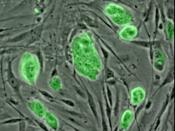Selecting the perfect name for their child is not the only thing new parents are concerned about anymore. During the late 1980s, something that was considered a medical waste and was discarded after birth is now saving the lives of many. Throughout the world today, parents are having to make the decision whether or not to save their babies' umbilical cords. Because cord blood banking is so controversial, many parents find this decision to be quite difficult.
If the parents do decide to keep it their child's umbilical cord, the next issue that they are faced with is where to store it. These umbilical cords can't just be taken home and be put in the back of the freezer. They either have to be stored with a private facility or with a public medical resource. When storing umbilical cords, the actual cord is not saved. Instead, the blood from the cord is draw out with a needle and injected into a plastic tube, where it is then frozen.
Both of these options have their positive and negative aspects.
Privately storing umbilical cords guarantees that only members of the family can access their resource. Although this method can be quite costly, it is very practical if a disease that can be cured by cord stem cells is present in the family. Stem cells that come from a direct family member have a much better chance working correctly when transplanted to another direct family member. If a family can afford this type of storage, and there is a health problem in the family, even if that problem cannot currently be treated by stem cells, family doctors may advise that they keep the cords privately. This is because research and technology are growing so rapidly, that who knows what will be possible ten...


